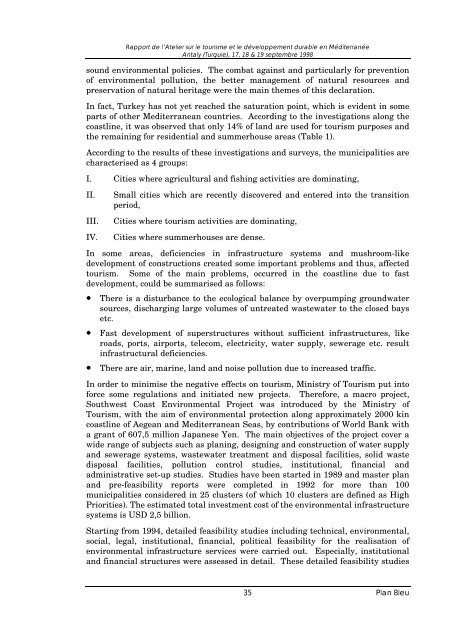MEDITERRANEAN ACTION PLAN
MEDITERRANEAN ACTION PLAN
MEDITERRANEAN ACTION PLAN
Create successful ePaper yourself
Turn your PDF publications into a flip-book with our unique Google optimized e-Paper software.
Rapport de l’Atelier sur le tourisme et le développement durable en Méditerranée<br />
Antaly (Turquie), 17, 18 & 19 septembre 1998<br />
sound environmental policies. The combat against and particularly for prevention<br />
of environmental pollution, the better management of natural resources and<br />
preservation of natural heritage were the main themes of this declaration.<br />
In fact, Turkey has not yet reached the saturation point, which is evident in some<br />
parts of other Mediterranean countries. According to the investigations along the<br />
coastline, it was observed that only 14% of land are used for tourism purposes and<br />
the remaining for residential and summerhouse areas (Table 1).<br />
According to the results of these investigations and surveys, the municipalities are<br />
characterised as 4 groups:<br />
I. Cities where agricultural and fishing activities are dominating,<br />
II. Small cities which are recently discovered and entered into the transition<br />
period,<br />
III. Cities where tourism activities are dominating,<br />
IV. Cities where summerhouses are dense.<br />
In some areas, deficiencies in infrastructure systems and mushroom-like<br />
development of constructions created some important problems and thus, affected<br />
tourism. Some of the main problems, occurred in the coastline due to fast<br />
development, could be summarised as follows:<br />
• There is a disturbance to the ecological balance by overpumping groundwater<br />
sources, discharging large volumes of untreated wastewater to the closed bays<br />
etc.<br />
• Fast development of superstructures without sufficient infrastructures, like<br />
roads, ports, airports, telecom, electricity, water supply, sewerage etc. result<br />
infrastructural deficiencies.<br />
• There are air, marine, land and noise pollution due to increased traffic.<br />
In order to minimise the negative effects on tourism, Ministry of Tourism put into<br />
force some regulations and initiated new projects. Therefore, a macro project,<br />
Southwest Coast Environmental Project was introduced by the Ministry of<br />
Tourism, with the aim of environmental protection along approximately 2000 kin<br />
coastline of Aegean and Mediterranean Seas, by contributions of World Bank with<br />
a grant of 607,5 million Japanese Yen. The main objectives of the project cover a<br />
wide range of subjects such as planing, designing and construction of water supply<br />
and sewerage systems, wastewater treatment and disposal facilities, solid waste<br />
disposal facilities, pollution control studies, institutional, financial and<br />
administrative set-up studies. Studies have been started in 1989 and master plan<br />
and pre-feasibility reports were completed in 1992 for more than 100<br />
municipalities considered in 25 clusters (of which 10 clusters are defined as High<br />
Priorities). The estimated total investment cost of the environmental infrastructure<br />
systems is USD 2,5 billion.<br />
Starting from 1994, detailed feasibility studies including technical, environmental,<br />
social, legal, institutional, financial, political feasibility for the realisation of<br />
environmental infrastructure services were carried out. Especially, institutional<br />
and financial structures were assessed in detail. These detailed feasibility studies<br />
35<br />
Plan Bleu
















